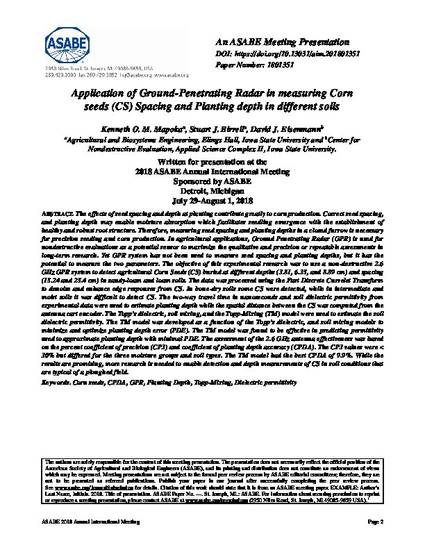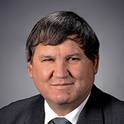
The effects of seed spacing and depth at planting contribute greatly to corn production. Correct seed spacing, and planting depth may enable moisture absorption which facilitates seedling emergence with the establishment of healthy and robust root structure. Therefore, measuring seed spacing and planting depths in a closed furrow is necessary for precision seeding and corn production. In agricultural applications, Ground Penetrating Radar (GPR) is used for nondestructive evaluations as a potential sensor to maximize the qualitative and precision or repeatable assessments in long-term research. Yet GPR system has not been used to measure seed spacing and planting depths, but it has the potential to measure the two parameters. The objective of this experimental research was to use a non-destructive 2.6 GHz GPR system to detect agricultural Corn Seeds (CS) buried at different depths (3.81, 6.35, and 8.89 cm) and spacing (15.24 and 25.4 cm) in sandy-loam and loam soils. The data was processed using the Fast Discrete Curvelet Transform to denoise and enhance edge responses from CS. In bone-dry soils some CS were detected, while in intermediate and moist soils it was difficult to detect CS. The two-way travel time in nanoseconds and soil dielectric permittivity from experimental data were used to estimate planting depth while the spatial distance between the CS was computed from the antenna cart encoder. The Topp‘s dielectric, soil mixing, and the Topp-Mixing (TM) model were used to estimate the soil dielectric permittivity. The TM model was developed as a function of the Topp‘s dielectric, and soil mixing models to minimize and optimize planting depth error (PDE). The TM model was found to be effective in predicting permittivity used to approximate planting depth with minimal PDE. The assessment of the 2.6 GHz antenna effectiveness was based on the percent coefficient of precision (CP3) and coefficient of planting depth accuracy (CPDA). The CP3 values were < 30% but differed for the three moisture groups and soil types. The TM model had the best CPDA of 9.9%. While the results are promising, more research is needed to enable detection and depth measurements of CS in soil conditions that are typical of a ploughed field.
Available at: http://works.bepress.com/stuart_birrell/58/

This proceeding is published as Mapoka, Kenneth OM, Stuart J. Birrell, and David J. Eisenmann. "Application of Ground-Penetrating Radar in measuring Corn seeds (CS) Spacing and Planting depth in different soils." 2018 ASABE Annual International Meeting, Detroit, MI, July 29-August 1, 2018. Paper no. 1801351. DOI: 10.13031/aim.201801351. Posted with permission.